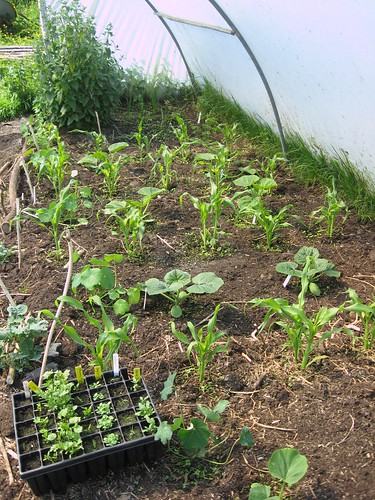


|
Commenced:
|
01/01/1995 |
|---|---|
|
Submitted:
|
24/05/2012 |
|
Last updated:
|
15/10/2021 |
|
Location:
|
Clogher, Kilfenora, Co. Clare, IE |
|
Climate zone:
|
Cool Temperate |
(projects i'm involved in)
Project: Sailchearnach
Posted by Ute Bohnsack almost 12 years ago
Spring was slow to show its face but eventually it did come, spring flowers made their appearance, the bees began to replenish their supplies, here on Lesser celandine, one of the first flowers on our land.


Daffodils, comfrey, horseradish and garlic planted under fruit trees awakened. Grass growth was very late and slow to start with spring temperatures about 3C below normal. This presented a difficulty as fodder became very scarce around the country and hay prices soared - a legacy of the previous extremely wet year which had hampered fodder conservation. Ireland suffered a fodder crisis and had to import hay from Britain and France. The Emerald Isle running out of grass is a bit like the North Pole running out of ice!

Our baby goats, 6 in all, were born into this cold spring at the end of March and their mums were still on hay. Their field, normally green, was parched and brown.
By mid May finally enough grass had build up to move the goats around the farm to strip-graze or mob-graze any bit of ground outside their half acre paddock that could be made safe with electric nets,


With May drawing to a close the blossoms came: apple, pear, hawthorn, lilac, wildflowers such as dandelion and creeping buttercup, as well as 'soul food' tulips.





Now that we have a "backbone" of shelterbelts established, we keep adding more permanent crops such as fruit trees and shrubs. What looks like an ordinary hedge...

... is in fact Edible Landscaping...

Meanwhile I got my potatoes planted in mulch beds, only about 100 tubers but of a nice range of varieties from first earlies to late maincrop, many of them from the Irish Seedsavers. Harvesting began in the polytunnel, starting with radishes and chard, then sizeable bowls of greens and herbs daily from the polyculture beds.


The tender summer veg and herbs I had started in plug trays were planted in the other polytunnel: Maize, beans and squash, tomatoes, aubergines, peppers, kiwano, cucumbers, courgettes, cape gooseberries joined by various herbs, nasturtiums, Tagetes ...This tunnel hosted a bunch of roosters over the winter who had cleared and fertilized the ground, helping to break down all of the previous season's crop residues, adding it to the soils organic matter. I intentionally leave a bit of weedy vegetation on the edges as that is where the slug-eating ground beetles and the green-fly munching ladybird larvae hang out when the rest of the soil is bared for planting. If I destroyed their home they could not work for me.

All the trees were leafing up. Our sweet rowans (Sorbus aucuparia 'Moravica') interspersed in the hedgerow sheltering the property from the North are showing promise this year.

Also in that hedgerow, on the southern side, are several gooseberries and black and red currants. This spring I added some raspberries (and loads more daffodils).

Late June brought the elder blossom: Happy bees. And I'm hoping for lots of berries for elderberry juice, the best cold remedy in the winter.

Moving into July, the potatoes are doing great. The first earlies should be ready by the end of the month.

Interesting things happen with mulching: A bunch of mushrooms appeared in the potato patch, pushing up the paper sacks covered with soiled waste hay from the goat yard.

The polytunnel crops have exploded into growth; sweetcorn cobs are forming and the first cucumbers and courgettes are ready for harvest. The tomato harvest should get underway in a week or two.

The tomatoes have begun to flower - one each of 15 varieties, most of them heirloom varieties, grown on a linear mound of half-rotted goat manure. Basil is their companion crop.

3 varieties of Physalis, a new venture for me, are growing like weeds.

I'm a great fan of shrub roses, primarily for their beauty and their scent, but they are also great for pollinators, and of course the hips can be used for tea and such. July is filled with their beautiful scent.

Rosa rugosa 'Hansa'
 Rosa glauca
Rosa glauca
 Rosa gallica 'Complicata'
Rosa gallica 'Complicata'


Rosa rugosa 'Scabrosa'

Rosa rubiginosa
The chickens have been doing good too, having produced more than 2700 eggs for us and for sale so far, 34 chicks and 17 table birds (from last year).


I have done hardly any outdoor growing in recent years (polytunnels only) but want to get back into it, by creating a bunch of mulch beds using animal bedding, compost and ramial woodchips. Unfortunately my chipper broke and I haven't yet managed to get the parts to fix it but made a start anyway. The idea is to have a semi-circle of 6 or 7 round permanently mulched beds in a nice micro-climate that has evolved in recent years due to shelter plantings. Here's #1 with lettuces, leeks and kale.

In early July we butchered the 4 male goat kids - sad but unavoidable. On the upside we have more than 30kg of kidmeat in the freezer and I can also now milk 3 nanny goats. With 3 l of milk a day there is plenty left for making soft cheese in all sorts of variations, from savoury cheese with herbs and spices to fruity desserts or yummy cheesecake.

 "Chop & drop" or "cut & bring" ? Willow for the goats.
"Chop & drop" or "cut & bring" ? Willow for the goats.
As of today, July 19, Ireland is officially in a drought with Day 15 in a heatwave with most unusual temperatures for this country in the high 20s and reaching 30C in many places. What a change from the dull, cool and incredibly wet summer of last year.
I'll leave you with this 5 a.m. image taken this morning of mist covered pastureland. I wonder what the rest of the summer will bring?

You must be logged in to comment.


Note: The various badges displayed in people profiles are largely honesty-based self-proclamations by the individuals themselves. There are reporting functions users can use if they know of blatant misrepresentation (for both people and projects). Legitimacy, competency and reputation for all people and projects can be evidenced and/or developed through their providing regular updates on permaculture work they’re involved in, before/after photographs, etc. A spirit of objective nurturing of both people and projects through knowledge/encouragement/inspiration/resource sharing is the aim of the Worldwide Permaculture Network.
 |
MemberA member is a permaculturist who has never taken a PDC course. These cannot become PDC teachers. Members may be novice or highly experienced permaculturists or anywhere in between. Watch their updates for evaluation. |
|---|---|
  |
Permaculture MatchmakerOne of these badges will show if you select your gender and the "I'm single, looking for a permaculture partner" option in your profile. |
 |
PDCPeople who claim to have taken a Permaculture Design Certificate (PDC) course somewhere in the world. |
 |
PDC VerifiedPeople who have entered an email address for the teacher of their PDC course, and have had their PDC status verified by that teacher. Watch their updates for evaluation. |
 |
PRI PDCPeople who’ve taken a Permaculture Research Institute PDC somewhere in the world. |
 |
PDC TeacherPeople who claim to teach some version of PDC somewhere in the world. |
 |
PRI TeacherWith the exception of the ‘Member’ who has never taken a PDC, all of the above can apply to become a PRI PDC Teacher. PRI PDC Teachers are those who the PRI recognise, through a vetting board, as determined and competent to teach the full 72-hour course as developed by Permaculture founder Bill Mollison – covering all the topics of The Designers’ Manual as well as possible (i.e. not cherry picking only aspects the teacher feels most interested or competent in). Such teachers also commit to focussing on the design science, and not including subjective spiritual/metaphysical elements. The reason these items are not included in the PDC curriculum is because they are “belief” based. Permaculture Design education concerns itself with teaching good design based on strategies and techniques which are scientifically provable. PRI PDC Teachers may be given teaching and/or consultancy offerings as they become available as the network grows. |
 |
Aid WorkerThe individual with this badge is indicating they are, have, or would like to be involved in permaculture aid work. As such, the individual may or may not have permaculture aid worker experience. Watch their updates for evaluation. |
 |
ConsultantThe individual with this badge is indicating they are, have, or would like to do paid permaculture design consultancy work. As such, the individual may or may not have permaculture consultancy experience. Watch their updates for evaluation. |
 |
Community ProjectCommunity projects are projects that help develop sustainable community interaction and increase localised resiliency. |